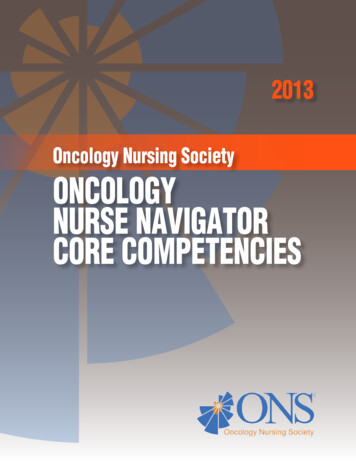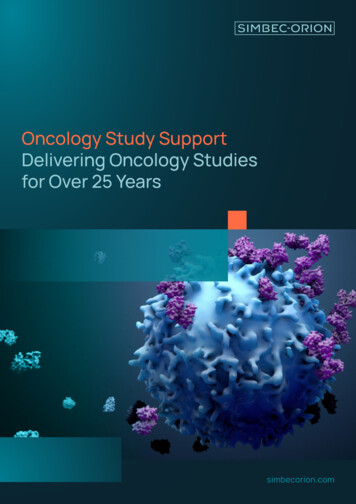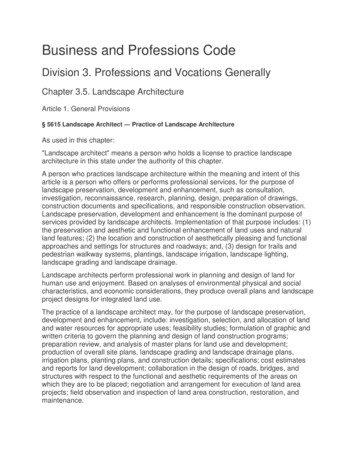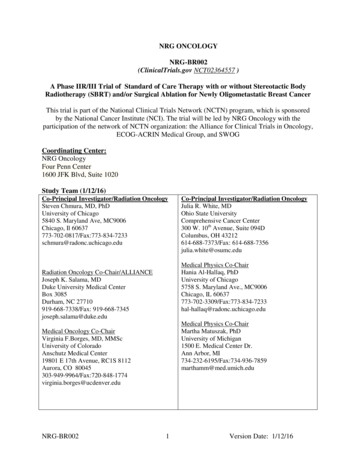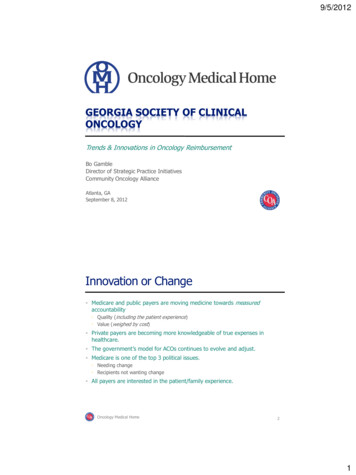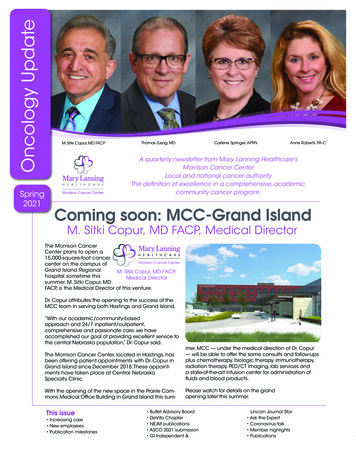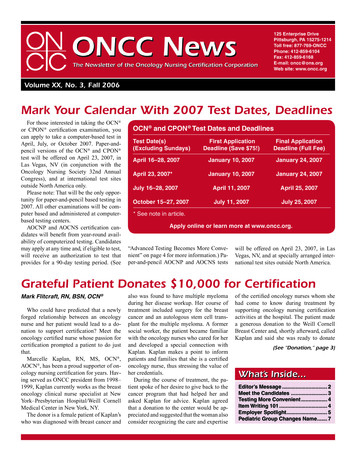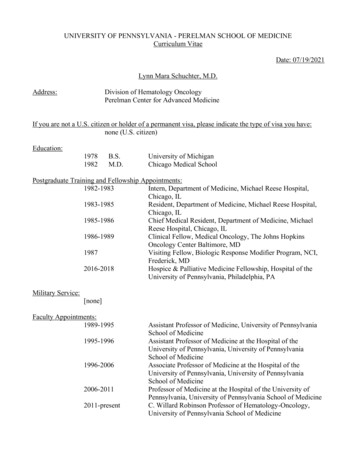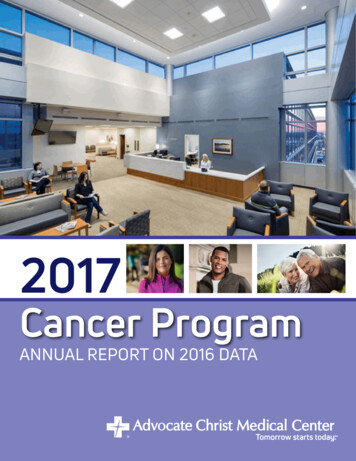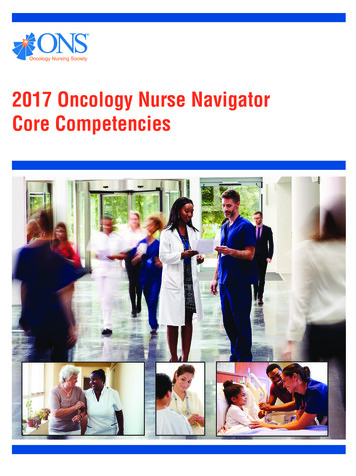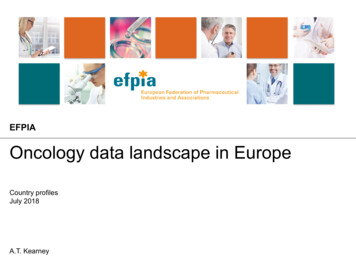
Transcription
EFPIAOncology data landscape in EuropeCountry profilesJuly 2018A.T. Kearney
DisclaimerThe following research has been conducted by A.T. Kearney and IQVIA, and does notconstitute an EFPIA position on health data in oncology.www.efpia.eu2
Executive summary This document outlines the key characteristics and maturity level of health data in 10European countries We conducted a landscape review and 40 interviews (16 internal interviews withoncology and RWD experts across 11 pharmaceutical companies and 22 external interviewsacross 8 countries) Each country has been rated quantitively and qualitatively across five characteristics:political, economic, societal, technical and legal Although most countries are embracing health data to some level, disparities exist inthe ease of access and quality of data collected:– The Nordics and UK are the leading countries in Europe, where national strategies and centralisedhealth systems foster access, sharing and quality– Countries like the Netherlands, France, Spain and others are developing their health data abilities,but are either in early stages or facing some pushback– Germany and Italy are lagging behind the rest of Europe, where strict privacy rules and fragmentedhealth systems impede collection and use of oncology health dataSource: A.T. Kearney; IQVIAwww.efpia.eu3
Contents Background & method European overview Country profileswww.efpia.eu4
Each country has been rated qualitatively and quantitively acrossthe five identified barriers, using desk research and interviewsMethod for country profilingQuantitative analysis ofcountry across key barriersQualitative analysis ofcountry across key barriers For each country, a quantitativeanalysis was conducted using deskresearch & stakeholder interviews,ranking countries across subcategories, under the key barriers: For each country, a qualitativeanalysis was conducted using deskresearch & stakeholder egal Case study examples are used tooutline the landscape in each country,under the five key barriers Where possible, country-specificnames have been included in theanalysisCountry mapping by barrier& overall data landscape For each country, an overall rankinghas been outlined covering:1. Severity of the barriers(high – low)2. Overall health data landscapeincluding key features(leading – emerging – lagging)Source: 16 interviews with oncology & RWD experts across 11 pharmaceutical companies (May 2018); A.T. Kearney analysiswww.efpia.eu5
Contents Background & method European overview Country profileswww.efpia.eu6
Scandinavian countries have the most advanced EHR systems;other countries face significant legal and political barriersOverview of health data in tseHealth platform introduced in 2008; data sharing limited to regional level;limited legislation on use of health dataCountry-wide EHR system in place; initiative underway to enable a sharedoncology database; lacking standards & data qualityEHRs owned by SHIs; poor linkage due to strict privacy rules; lack ofstandardsRegional EHR systems; lack of national eHealth and/or oncology plan;several managed-entry agreements in place for new oncology drugsGaps in a national EHR plan (but being solved); widespread use of EHRs;limited sharing across healthcare centres or quality standardsMandatory EHRs; plans to introduce a national patient account & IDsystem; legal issues around accessRegional EHRs despite national strategy; limited data sharing; lack of legalprocedures that hinders widespread accessNational EHR strategy that allows linkage across health centres &databases using a patient ID; clear & well-understood patient consentNational plan for EHRs but regional disparities; limited country-widesharing; ad hoc access approval, with few process standardsWidespread EHR adoption; independent body to establish national cancerdatabases; well-developed data quality & linkage across datasetsEHR electronic health records; SHI social health insurer;Source: Cancer Atlas; WHO. ‘Global eHealth survey’ (2015); European Commission. ‘Overview of national laws on EHR’ (2013); OECD. ‘Strengthening Health Info Infrastructure’(2015); Eurobarometer surveys on ‘Digital health literacy’ and ‘Data protection’; Taylor Wessing. ‘Global data protection guide’, access Mar 2018; OECDwww.efpia.eu“Health Data Governance”; External interviews; A.T. Kearney analysis; IQVIA analysis7
Legal and technological barriers are significant for severalEuropean countries; political barriers are slowly improvingCurrent health data barriers, by cSocietalTechnologicalLegalTotalBelgium France Germany Italy Netherlands Poland Spain Sweden Switzerland UK Country*Limited data for certain countries means that analysis of some barriers is inconclusiveSource: Cancer Atlas; WHO. ‘Global eHealth survey’ (2015); European Commission. ‘Overview of national laws on EHR’ (2013); OECD. ‘Strengthening Health Info Infrastructure’(2015); Eurobarometer surveys on ‘Digital health literacy’ and ‘Data protection’; Taylor Wessing. ‘Global data protection guide’, access Mar 2018; OECDwww.efpia.eu“Health Data Governance”; External interviews; A.T. Kearney analysis; IQVIA analysis8
Legal and technological barriers are significant for severalEuropean countries; political barriers are slowly improvingHealth data profile overview (1/2) yes / noPoliticaleHealthnationalstrategy low / medium / highNational eHealth policy or strategyNational plan or policy to implement EHRsNational plan or policy inc. 2 uses of dataImplementation of national EHRPrimary care facilities with EHRSpecialist facilities with EHRHospitals with EHR 70%80%75% N/AN/AN/A 80%80%90% 100%-Number of eHealth funding sources*Sum of eHealth funding amountsDriver of eHealth fundingPublic-private partnerships for 4/42/44/42/43/42/4100% 100% 100% 100% 100% 75% 100%Public Public Public Public Public PrivPub Public25%25%0%25%25%25%25%Use of Internet to search for health info.Knowledge of how to use health-related info. foundonlineTrust in health & medical bodies to protect dataHealth sciences students with pre-service training inTraining ineHealtheHealthHCPs with in-service training in eHealthTechnicalDiseaseQuality of population-based cancer registriescomplex. Operational national cancer plansDefinition Defined minimum datasetStructuring of data elements&standards Rules on common terminology for %25%75%25%38%25%--63%63%38%38%75%75%63% EHRsystemsEconomicProvisionof fundingSocietalPatienttrust &autonomy 100%100%100% 15%10%5% 90%25%70% 100%100%100% 20%90% 100%20%100%EHR electronic medical record; HCP healthcare professional; PPP public-private partnership; *Public, private / commercial, donor / non-public or PPPSource: Cancer Atlas; WHO. ‘Global eHealth survey’ (2015); European Commission. ‘Overview of national laws on EHR’ (2013); OECD. ‘Strengthening Health Info Infrastructure’www.efpia.eu(2015); Eurobarometer surveys on ‘Digital health literacy’ and ‘Data protection’; Taylor Wessing. ‘Global data protection guide’, access Mar 2018; OECD“Health Data Governance”; External interviews; A.T. Kearney analysis; IQVIA analysis9
Legal and technological barriers are significant for severalEuropean countries; political barriers are slowly improvingHealth data profile overview (2/2) yes / no low / medium / highTechnical (cont.) Electronic sharing of information about patientsInteroperaUse of unique identifying number for record linkage* 6/10bility &Use of national data to record linkage projects*7/10linkage Specific rules & standards on EHR interoperability Quality audits of EHR recordsQualityCertification that requires vendors to (1) adopt assurstandards & (2) use structure dataance Incentives or penalties to support qualityLegal Specific rules on hosting & processing of EHRs Specific authorisation to host & process EHRs Hosting & Legal requirement for encrypted data in EHRs Specific rules for archiving duration of EHRsprocess Specific law on 2 use of dataingrdUse of 3 parties to (1) create, (2) de-identify or (3)2/3approve data requests for access Legal rules on patient consentPatient Rules on a patient's consent to create EHRsconsent Rules on a patient's consent to share the EHR Rules on identification & access of HCPsAccess & Explicit prohibitionsupdate of Patient right to full accessEHRs Patient right to modify or erase data Requirement for DPO (pre-GDPR)Data Breach notification requirementprotection Cyber security law 5/104/10 3/100/10 - 4/100/10 7/107/10 3/105/10 10/109/10 - - - 2/33/3-3/33/33/33/3-1/3 EHR electronic medical record; DPO data protection officer; HCP healthcare professional ; *Out of 10 types of data that can be linkedSource: Cancer Atlas; WHO. ‘Global eHealth survey’ (2015); European Commission. ‘Overview of national laws on EHR’ (2013); OECD. ‘Strengthening Health Info Infrastructure’www.efpia.eu(2015); Eurobarometer surveys on ‘Digital health literacy’ and ‘Data protection’; Taylor Wessing. ‘Global data protection guide’, access Mar 2018; OECD“Health Data Governance”; External interviews; A.T. Kearney analysis; IQVIA analysis10
Contents Introduction European overview Country profileswww.efpia.eu11
Belgium is rapidly developing its health data infrastructure andmaking efforts to standardise, though legal barriers remainHealth data profile: Belgium (1/2) yes / ic low / medium / highNational eHealth policy or strategyNational plan or policy to implement EHRsNational plan or policy inc. 2 uses of dataImplementation of national EHRPrimary care facilities with EHRSpecialist facilities with EHRHospitals with EHR 70%80%75%Number of eHealth funding sources*Sum of eHealth funding amountsDriver of eHealth fundingPublic-private partnerships for eHealth3/4100%Public25%Use of Internet to search for health info.Knowledge of how to use health-related info. foundonlineTrust in health & medical bodies to protect dataHealth sciences students with pre-service training inTraining ineHealtheHealthHCPs with in-service training in eHealthTechnicalDiseaseQuality of population-based cancer registriescomplex. Operational national cancer plansDefinition Defined minimum datasetStructuring of data elements&standards Rules on common terminology for EHR56%Provisionof fundingSocietalPatienttrust &autonomy88%85%25%25% Deployment of shared EHRs since 2008 Public health monitoring is not yet incorporated in EHR plans, but itis part of EHR functionality; patient safety monitoring is beingconsidered as well, but the focus is on EHR deployment An eHealth Platform was established in 2008 that sets standardsfor clinical terminology & interoperability; working groupsdevelop standards & include representatives rom PFS Public Health,the National Insurance Institute & other public health institutions Exchange of data is organised at a regional level, using a federalreference directory, unique patient identifying number & commonstandards to ensure interoperability & achieve national coverage 3 sources (public, private, PPP) provide most of the eHealth funding,though there is no donor or non-public funding Public funding provides more than 75% Patients are as likely to use the Internet to search for health info(vs 59%) or know how to use it (vs 90%), & are more trusting (vs74%), than average patients in the EU A minimum dataset was implemented in 2003 but 5% of patientrecords actually contain it The ‘identificatienummer van de sociale zekerheid’ (INSZ) is theidentifying number used for healthcare, social security & tax Data linkage is conducted by networks of hospitals & with 5-6national databases using the INSZEHR electronic medical record; HCP healthcare professional; PPP public-private partnership; *Public, private / commercial, donor / non-public or PPPSource: Cancer Atlas; WHO. ‘Global eHealth survey’ (2015); European Commission. ‘Overview of national laws on EHR’ (2013); OECD. ‘Strengthening Health Info Infrastructure’www.efpia.eu(2015); Eurobarometer surveys on ‘Digital health literacy’ and ‘Data protection’; Taylor Wessing. ‘Global data protection guide’, access Mar 2018; OECD“Health Data Governance”; External interviews; A.T. Kearney analysis; IQVIA analysis12
Belgium is rapidly developing its health data infrastructure andmaking efforts to standardise, though legal barriers remainHealth data profile: Belgium (2/2) yes / no low / medium / highTechnical (cont.)Electronic sharing of information about patientsInteroperaUse of unique identifying number for record linkage*bility &Use of national data to record linkage projects*linkageSpecific rules & standards on EHR interoperabilityQuality audits of EHR recordsQualityCertification that requires vendors to (1) adoptassurstandards & (2) use structure dataanceIncentives or penalties to support qualityLegalSpecific rules on hosting & processing of EHRsSpecific authorisation to host & process EHRsHosting & Legal requirement for encrypted data in EHRsSpecific rules for archiving duration of EHRsprocessSpecific law on 2 use of dataingrdUse of 3 parties to (1) create, (2) de-identify or (3)approve data requests for accessLegal rules on patient consentPatientRules on a patient's consent to create EHRsconsentRules on a patient's consent to share the EHRRules on identification & access of HCPsAccess &Explicit prohibitionsupdate ofPatient right to full accessEHRsPatient right to modify or erase dataRequirement for DPO (pre-GDPR)DataBreach notification requirementprotectionCyber security law 6/107/10 2/3 Cancer registry data is linked to mortality data, to health insurancenomenclature, to hospital in-patient data & to cancer screening– As a result of the legislation specific to the cancer registry, theCommission for the Protection of Privacy (CPP) has approvedthe cancer registry to collect identifiable personal health data, linkthe data & then to conduct analysis of de-identified data In general, data linkage takes place within the E-health Platform,as a third party authorised by law to access/use identifiable healthdata & that is trusted to undertake data linkages that are approvedby the CPP 2 uses of data include general research & scientific purpose,statistics & historical purpose The CPP grants authority to collect & use identifiable personalinformation without consent, & approves data linkage projects –only de-identified data is provided to governmental & nongovernmental researchers for analysis After the introduction of the EU Data ProtectionDirective, theCPP advised the cancer registry that it could no longer processidentifiable personal health data & that the only way to continuenormal operations would be to draft authorising legislation & reapplyfor permission;– The legislation authorising the cancer registry now clarifies thatpatient consent is not required to create the registry, link oranalyse the data– This took time & the quality of the registry suffered No specific breach notification rules exists, but guidance is givento companies to notify in the case of “public incidents”EHR electronic medical record; DPO data protection officer; HCP healthcare professional ; *Out of 10 types of data that can be linkedSource: Cancer Atlas; WHO. ‘Global eHealth survey’ (2015); European Commission. ‘Overview of national laws on EHR’ (2013); OECD. ‘Strengthening Health Info Infrastructure’www.efpia.eu(2015); Eurobarometer surveys on ‘Digital health literacy’ and ‘Data protection’; Taylor Wessing. ‘Global data protection guide’, access Mar 2018; OECD“Health Data Governance”; External interviews; A.T. Kearney analysis; IQVIA analysis13
France shows mature adoption of EHRs allowing sharing, buttechnical barriers impact quality and standardsHealth data profile: France (1/2) yes / icProvisionof fundingSocietal low / medium / highNational eHealth policy or strategyNational plan or policy to implement EHRsNational plan or policy inc. 2 uses of dataImplementation of national EHRPrimary care facilities with EHRSpecialist facilities with EHRHospitals with EHR N/AN/AN/ANumber of eHealth funding sources*Sum of eHealth funding amountsDriver of eHealth fundingPublic-private partnerships for eHealthN/AN/AN/AN/AUse of Internet to search for health info.63%Knowledge of how to use health-related info. found87%online79%Trust in health & medical bodies to protect dataHealth sciences students with pre-service training inTraining ineHealtheHealthHCPs with in-service training in eHealthTechnical DiseaseQuality of population-based cancer registries complex. Operational national cancer plans Definition Defined minimum dataset Structuring of data elements& standards Rules on common terminology for EHRPatienttrust &autonomy Deployment of shared EHRs since 2006 A collaborative project between the National Institute for Cancer& Agence des Systemes d’Information Partages de Sante (ASIPSanté) is underway to build a database for shared oncologyrecords with a single custodian The national cancer plan (‘Plan Cancer 2014-2019’) has a fullchapter dedicated to the use of robust & shared data, to betterunderstand care pathways & inequalities, & have a strongobservational system in place The ASIP Sante, representing industry, patients, legal & healthprofessionals, took responsibility for setting all operabilitystandards & agreements with data custodians in 2009 Exchange of data is permitted via implementation of a country-wideEHR system Patients are as likely to use the Internet to search for health info(vs 59%), or know how to use it (vs 90%), & are more trusting (vs74%), than average patients in the EU There are no minimum datasets & patients specify the elementsof the EHRs to be shared The ‘numéro d’identification au répertoire’ (NIR) is used for medicalinsurance, but is different from the numbers used for linkageacross hospitals; discussions are underway to use a 3rd party tolink these together Data linkage is conducted with 5-6 databases using the NIREHR electronic medical record; HCP healthcare professional; PPP public-private partnership; *Public, private / commercial, donor / non-public or PPPSource: Cancer Atlas; WHO. ‘Global eHealth survey’ (2015); European Commission. ‘Overview of national laws on EHR’ (2013); OECD. ‘Strengthening Health Info Infrastructure’www.efpia.eu(2015); Eurobarometer surveys on ‘Digital health literacy’ and ‘Data protection’; Taylor Wessing. ‘Global data protection guide’, access Mar 2018; OECD“Health Data Governance”; External interviews; A.T. Kearney analysis; IQVIA analysis14
France shows mature adoption of EHRs allowing sharing, buttechnical barriers impact quality and standardsHealth data profile: France (2/2) yes / no low / medium / highTechnical (cont.)Electronic sharing of information about patientsInteroperaUse of unique identifying number for record linkage*bility &Use of national data to record linkage projects*linkageSpecific rules & standards on EHR interoperabilityQuality audits of EHR recordsQualityCertification that requires vendors to (1) adoptassurstandards & (2) use structure dataanceIncentives or penalties to support qualityLegalSpecific rules on hosting & processing of EHRsSpecific authorisation to host & process EHRsHosting & Legal requirement for encrypted data in EHRsSpecific rules for archiving duration of EHRsprocessSpecific law on 2 use of dataingrdUse of 3 parties to (1) create, (2) de-identify or (3)approve data requests for accessLegal rules on patient consentPatientRules on a patient's consent to create EHRsconsentRules on a patient's consent to share the EHRRules on identification & access of HCPsAccess &Explicit prohibitionsupdate ofPatient right to full accessEHRsPatient right to modify or erase dataRequirement for DPO (pre-GDPR)DataBreach notification requirementprotectionCyber security law 5/104/10 In general, France has invested in methods for the deidentification of data, using a hashing algorithm that convertsnames to a numerical code that cannot be reversed Codes are used to build longitudinal health histories, but given theneed to verify content in health records for research studies, Francehas since developed a reversible hashing algorithm 2/3 French law protects the privacy & security of private healthinformation; consideration in the law for 2 uses cover generalresearch / scientific purposes The ‘Commission Nationale de l’Information et des Libertés’ (CNIL)is a data protection authority that authorises access on a case-bycase basis for projects requiring access to health data Considerations include: legality of request; legitimacy ofresearchers; affiliations with credible organisations & use ofsecurity measures The CNIL may approve sharing of data to another EU country Non-government researchers must also be approved by ‘le Comitédu Secret statistique’ of the ‘Conseil national de l’informationstatistique (CNIS) A French law came into affect in 2004 that stipulates HCPs mustrefer to EHRs where in place & commit to completing themaccording to clinical terminology & interoperability standardsEHR electronic medical record; DPO data protection officer; HCP healthcare professional; *Out of 10 types of data that can be linkedSource: Cancer Atlas; WHO. ‘Global eHealth survey’ (2015); European Commission. ‘Overview of national laws on EHR’ (2013); OECD. ‘Strengthening Health Info Infrastructure’www.efpia.eu(2015); Eurobarometer surveys on ‘Digital health literacy’ and ‘Data protection’; Taylor Wessing. ‘Global data protection guide’, access Mar 2018; OECD“Health Data Governance”; External interviews; A.T. Kearney analysis; IQVIA analysis15
Germany lacks a national approach to EHRs and technicalbarriers limit sharing, linkage and use of data for researchHealth data profile: Germany (1/2) yes / icProvisionof fundingSocietal low / medium / highNational eHealth policy or strategyNational plan or policy to implement EHRsNational plan or policy inc. 2 uses of dataImplementation of national EHRPrimary care facilities with EHRSpecialist facilities with EHRHospitals with EHR 80%80%90%Number of eHealth funding sources*Sum of eHealth funding amountsDriver of eHealth fundingPublic-private partnerships for eHealthN/AN/AN/AN/AUse of Internet to search for health info.57%Knowledge of how to use health-related info. found87%online77%Trust in health & medical bodies to protect dataHealth sciences students with pre-service training inTraining ineHealtheHealthHCPs with in-service training in eHealthTechnical DiseaseQuality of population-based cancer registries complex. Operational national cancer plans Definition Defined minimum dataset Structuring of data elements& standards Rules on common terminology for EHRPatienttrust &autonomy Currently there are no national, shared EHR systems; someinitiatives are underway to change this A government plan to introduce the electronic health card in 2006was delayed to 2015 due to physicians’ concerns around privacy The national cancer plan mandates the contribution to a nationalcancer registry funded by SHIs; each state then sends oncology datato the Centre for Cancer Registry data at the Robert Koch instituteon an annual basis; the data is screened for completeness &analysis is shared at a national level Gematik is a healthcare provider organisation that sets out toestablish a national telematics infrastructure & provides guidanceon the implementation of interoperable documentation systems N/A Patients are as likely to use the Internet to search for health info(vs 59%) or know how to use it (vs 90%), & are more trusting (vs74%), than patients in the EU No minimum datasets are defined nationally, with definitionspecific to care situation implemented by organisations of HCPs Data linkage is not conducted at the national level but at the statelevel in some states: Bremen, Hessen, Augsburg & Essen, whereauthorised by law Legislation differs for cancer registries to identify whichinformation may be used to record linkage SHIs such as Barmer-GEK & AOK also conduct linkage of dataEHR electronic medical record; HCP healthcare professional; PPP public-private partnership; *Public, private / commercial, donor / non-public or PPPSource: Cancer Atlas; WHO. ‘Global eHealth survey’ (2015); European Commission. ‘Overview of national laws on EHR’ (2013); OECD. ‘Strengthening Health Info Infrastructure’www.efpia.eu(2015); Eurobarometer surveys on ‘Digital health literacy’ and ‘Data protection’; Taylor Wessing. ‘Global data protection guide’, access Mar 2018; OECD“Health Data Governance”; External interviews; A.T. Kearney analysis; IQVIA analysis16
Germany lacks a national approach to EHRs and technicalbarriers limit sharing, linkage and use of data for researchHealth data profile: Germany (2/2) yes / no low / medium / highTechnical (cont.) Electronic sharing of information about patientsInteroperaUse of unique identifying number for record linkage* 3/10bility &Use of national data to record linkage projects*0/10linkage Specific rules & standards on EHR interoperability Quality audits of EHR recordsQualityCertification that requires vendors to (1) adopt assurstandards & (2) use structure dataance Incentives or penalties to support qualityLegal Specific rules on hosting & processing of EHRs Specific authorisation to host & process EHRs Hosting & Legal requirement for encrypted data in EHRs Specific rules for archiving duration of EHRsprocess Specific law on 2 use of dataingrdUse of 3 parties to (1) create, (2) de-identify or (3)3/3approve data requests for access Legal rules on patient consentPatient Rules on a patient's consent to create EHRsconsent Rules on a patient's consent to share the EHR Rules on identification & access of HCPsAccess & Explicit prohibitionsupdate of Patient right to full accessEHRs Patient right to modify or erase data Requirement for DPO (pre-GDPR)Data Breach notification requirementprotection Cyber security law Names, addresses & date of births are available, but place of birthis not universally available for probabilistic record linkage All German states can use the same pseudonymisation algorithmto render names anonymous, thus making it possible to mergerecords at the Centre for Cancer Registry data & correct forbiases due to patient mobility Health insurance number is mandatory & used for data exchange Personal health information can only be used for original intendedpurposes & e-Health data is collected for medical care; no other 2 purposes are specified in German law Explicit allowances can be made possible by law (e.g. for billing,monitoring or healthcare quality) to access health record data Researchers can access only de-identified data from cancerregistries; some identifiers may be approved to remain on file (e.g.date & place of birth) if there is justification for inclusion – thedecision depends of re-identification risk The Centre for Cancer Registry Data makes data available forresearch purposes to external scientists through a scientific-usefile, but any amalgamation of data from a state’s research projects,especially the linkage of cancer registries to other data sources,requires state approval Data protection laws are established at the Federal & Land level Each of the 16 German states has a State Data ProtectionCommissioner who is responsible for service providers of thesocial security administration at the state level Data subjects & regulators must be notified of data breaches if thebreach involves particularly sensitive data (e.g. health data)EHR electronic medical record; DPO data protection officer; HCP healthcare professional ; *Out of 10 types of data that can be linkedSource: Cancer Atlas; WHO. ‘Global eHealth survey’ (2015); European Commission. ‘Overview of national laws on EHR’ (2013); OECD. ‘Strengthening Health Info Infrastructure’www.efpia.eu(2015); Eurobarometer surveys on ‘Digital health literacy’ and ‘Data protection’; Taylor Wessing. ‘Global data protection guide’, access Mar 2018; OECD“Health Data Governance”; External interviews; A.T. Kearney analysis; IQVIA analysis17
Italy has a fragmented EHR landscape across regions, but codingstandards are intended to support linkage at the national levelHealth data profile: Italy (1/2) yes / noPoliticaleHealthnationalstrategy low / medium / highNational eHealth policy or strategyNational plan or policy to implement EHRsNational plan or policy inc. 2 uses of dataImplementation of national EHRPrimary care facilities with EHRSpecialist facilities with EHRHospitals with EHR 100%-Number of eHealth funding sources*Sum of eHealth funding amountsDriver of eHealth fundingPublic-private partnerships for eHealth4/4100%Public25%Use of Internet to search for health info.Knowledge of how to use health-related info. foundonlineTrust in health & medical bodies to protect dataHealth sciences students with pre-service training inTraining ineHealtheHealthHCPs with in-service training in eHealthTechnicalDiseaseQuality of population-based cancer registriescomplex. Operational national cancer plansDefinition Defined minimum datasetStructuring of data elements&standards Rules on common terminology for EHR59%EHRsystemsEconomicProvisionof fundingSocietalPatienttrust &autonomy87%64%25%63%
EHR electronic medical record; HCP healthcare professional; PPP public -private partnership; *Public, private / commercial, donor / non-public or PPP . Certification that requires vendors to (1) adopt . (2015); Eurobarometer surveys on 'Digital health literacy' and 'Data protection'; Taylor Wessing. .
